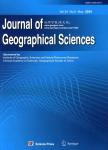1960-2015年中国绿洲胡杨生长季对全球变暖的时空响应及原因(英文)
The spatiotemporal responses of Populus euphratica to global warming in Chinese oases between 1960 and 2015作者机构:College of Geography and Environmental Science Northwest Normal University
出 版 物:《Journal of Geographical Sciences》 (地理学报(英文版))
年 卷 期:2018年第28卷第5期
页 面:579-594页
核心收录:
学科分类:0709[理学-地质学] 07[理学] 0704[理学-天文学] 0713[理学-生态学]
基 金:National Natural Science Foundation of China,No.40961035,No.41461012 Science and Technology Project of Gansu Province,No.0803RJZA094
主 题:Populus euphratica annual growing season global warming responses to climate change Chinese oases
摘 要:Daily average temperature data from 48 meteorological stations in Chinese oases that are within the distribution area of Populus euphratica were analyzed to determine the spatiotemporal responses of this tree to climate change. Specifically, the start and end date as well as the number of days that comprised the growing season were analyzed with a multi-year trend line and using the Mann-Kendall mutation test, inverse distance weighted interpolation(IDW) in the software Arc GIS, a Morlet wavelet power spectrum, and correlation analysis. The results of this study show that, over the last 56 years, the start date of the P. euphratica growing season has advanced, while the end date has been postponed, and the number of days that comprise the growing season have gradually increased. The changing trend rates recovered in this analysis for these three time slices are –1.34 d/10 a, 1.33 d/10 a, and 2.66 d/10 a(α ≥ 0.001), respectively. Data show that while spatial disparity is extremely significant, it is nevertheless the case that along a southwest-to-northeast transect of Chinese oases, the later the start date of the P. euphratica season, the sooner the end data and the shorter the growing season. Mutations points in start and end date, as well as for the growing season overall were observed in 2001, 1989, and 1996, respectively, and the data presented in this paper show that, in particular, the date of this end of this period is most sensitive to climate warming. Growing season cycles for P. euphratica are between 3.56 years and 7.14 years, consistent with the periodicity of El Ni?o events, while a start date cycle between 3.56 years and 4.28 years is consistent with atmospheric circulation cyclicity. The causal analysis presented in this paper shows that the Asian polar vortex area index(APVAI), the Qinghai-Tibet Plateau index(TPI), the westerly circulation index(WCI), and carbon dioxide emissions(CDE) are the main factors influencing spatiotemporal changes in the growth of P. euphratica, the effect of latitude during the growing season is more significant than altitude, and the start date of the growing season is more significantly influenced by these factors than end date. In addition, data show that the start date, end date, and length of the growing season are all significantly correlated with their average corresponding monthly temperature(corre-lation coefficients are –0.875, 0.770, and 0.897; α≥0.001). Thus, if the average temperature in March increases by 1℃, the start date of the growing season will advance by 2.21 days, while if the average temperature in October increases by the same margin then the seasonal end date will be delayed by 2.76 days. Similarly, if the average temperature between March and October increases by 1℃, the growing season will be extended by 7.78 days. The results of this study corroborate the fact that changes in the P. euphratica growing are sensitive to regional warming and are thus of considerable theoretical significance to our understanding of the responses of Chinese vegetation to climate change as well as to ecological restoration.



